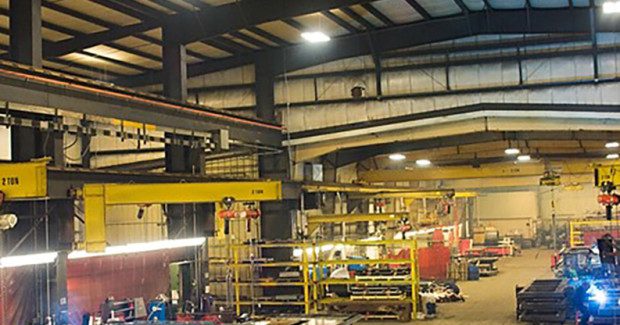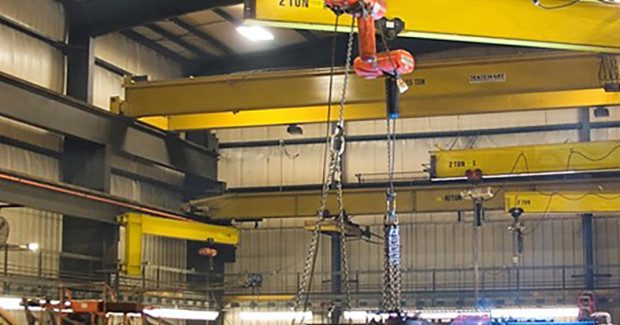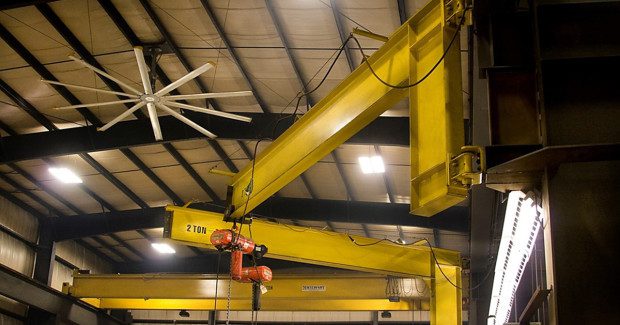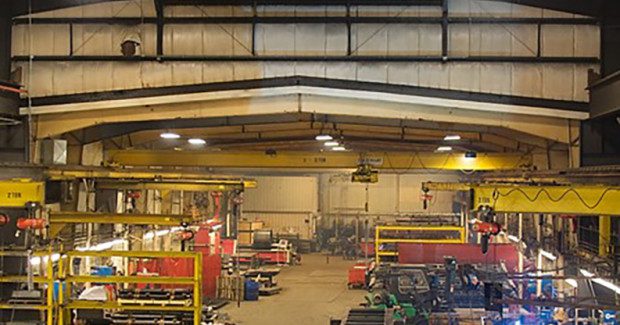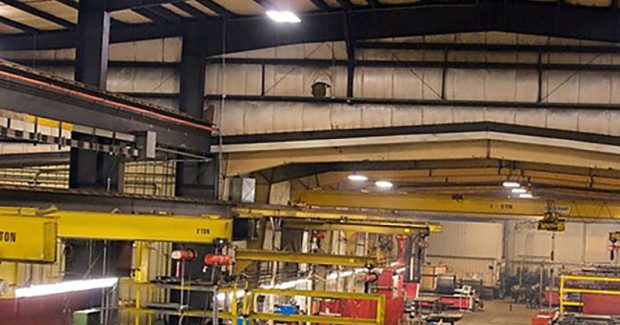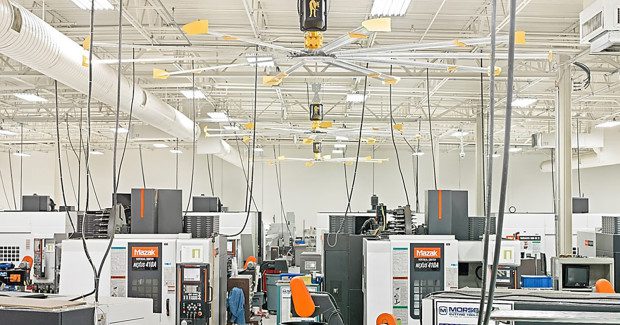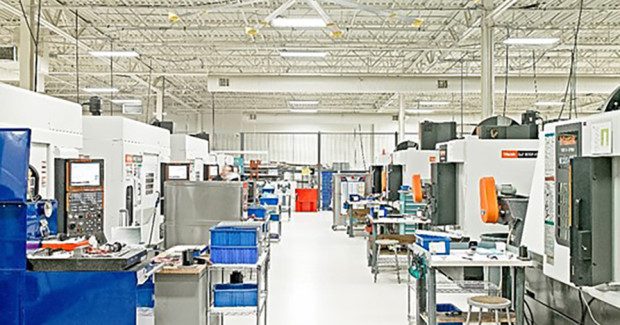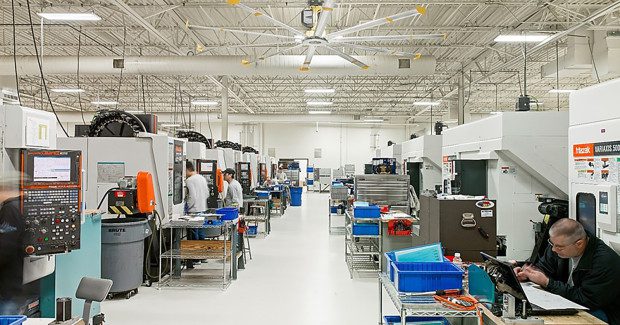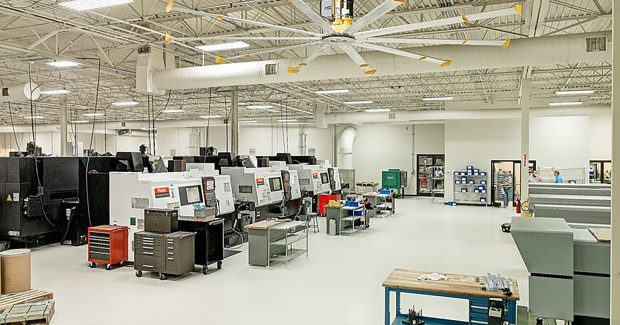The Importance of Air Movement in Metalworking Shops
Air movement is not new, but understanding how it can improve working conditions is bringing a wind of change to industrial facility design and management.
Posted: June 22, 2015
Air movement aids comfort and efficiency in metal facilities. Air movement is to comfort what energy savings are to the bottom line. Whether it’s a fabrication facility, distribution center, machine shop or warehouse setting, comfort is an underlying factor in the success of any work environment.
Air movement is not new, but understanding how it can improve working conditions is bringing a wind of change to industrial facility design and management. When it comes to thermal comfort, individuals might have different preferences, but following set parameters can appease a vast majority of occupants[i]. Supplying air movement through the use of large diameter overhead, which range from 8 ft to 24 ft in diameter, helps distribute conditioned air and creates a cooling effect in facilities where HVAC is not a viable option.
FUNCTIONAL MECHANICS
In order to understand the crucial role airflow plays in thermal comfort and energy efficiency, it’s important to first understand how these benefits are achieved mechanically. The optimal fan design involves finding the optimal combination of size, speed, airfoil shape and position to produce a cooling breeze to cover the largest floor area with while using the least amount of energy.
Properly engineered, large diameter, low speed overhead fans take advantage of their immense size — not speed — to move a massive amount of air in spaces where traditional, high velocity fans are rendered ineffective. “When the airfoil length is doubled, you’ve increased the surface area that those airfoils sweep by four. As the size gets larger, the amount of air the fan moves increases at a faster rate than the amount of power it takes to turn,” said Richard Oleson, a senior design engineer with Big Ass Fan Company (Lexington, KY). “So with all things being equal, the fan will become more efficient. The speed ranges at which a fan operates also contribute to effectiveness.”
https://youtu.be/VztjAvz4HO0
While running a fan faster may move a little more air, there is a point of diminishing returns, at which the increase in energy required exceeds the benefit of additional air movement and the system loses its efficiency. Airfoil design also affects the effectiveness of the fan. The shape of the foil combined with its pitch, or angle of attack, are the key parameters in determining how much air will be moved and how much energy will be required in the effort. “An exaggerated pitch — airfoils with an almost vertical angle of attack — will increase drag (and increase energy draw), while a flat, mostly horizontal airfoil will typically not move much air at all,” explains Oleson. “The most efficient angle lies somewhere in between.”
Additionally, AirFences installed along the airfoil redirect air that would otherwise slide off the end of the airfoil and be lost. These AirFences increase the efficiency of the fan, and along with airfoil and winglet shape, can help contribute up to an expansion in the air movement’s coverage area.
STEAMY WORKING CONDITIONS
Engineered Medical Systems, LLC (EMS; Bartlett, TN) runs 125 tons of air conditioning year round because the heat produced by its milling machines leads to unbearably hot working conditions. Machinists mold steel into lifesaving medical devices on an as-needed basis for customers. “Everything we do is made to order,” stated company controller Charles Stanford. “We don’t carry any inventory, and we don’t make anything if we don’t have an order for that instrument.” This approach means we can’t stock up on products in the cooler months and slow down operations as the temperatures soar.
Even during the winter, with the AC operating, indoor winter temperatures hover around 80 deg F, while indoor summer temperatures continue to climb. “We’ve got 60 machines in this shop, each one venting air at about 110 deg F, so we were having a lot of difficulty getting the place cool,” noted Stanford. A heat-load study indicated additional HVAC tonnage with a price tag of $100,000 to $150,000 was needed to lower the warehouse temperatures. But adding more cooling would not change the fact that machinist would still be standing in a pocket of hot air. To help circulate the cooled air throughout this 40,000 sq ft plant and provide the much-needed cooling effect, three large diameter, low speed fans were installed. The gentle breeze from the fans brings a welcome reprieve to the workers.
COMBINED OPERATION
In air conditioned facilities, fans can be used to efficiently circulate the conditioned air, reducing the need for ductwork and decreasing the system’s expected load. Fans are easily integrated into the mechanical system via a building automation system, increasing their effectiveness by operating as part of the HVAC system. “The front of the shop, where about 70 percent of the HVAC is, stays about 5 deg to 7 deg cooler than the back, so we run that fan at a slower speed,” explained Stanford. “The middle fan runs a little faster and the back fan, where we are short on HVAC, runs pretty strong. It has worked great. This is my third year here, and this was my first year not to hear any complaints.”
In warmer months, large diameter overhead fans improve occupant comfort through increased air movement. With the fans operating between 60 percent and 100 percent, the additional air movement creates a cooling sensation as a breeze passes over occupants’ skin. In the cooler months, mixing the air destratifies a space, pushing warm air back down from the ceiling resulting in more uniform temperatures, cost savings from reduced energy consumption and quicker warm-up times for buildings with varying occupancy.
By slowing the fan to 10 percent to 30 percent of its full speed, while still rotating in a forward direction, saving will accrue by slowly circulating heat trapped at the ceiling level down to the occupant/thermostat level before it is able to escape from the space. Even though the thermostat set point remains the same, the heating system does not have to run as long or work as hard to maintain the temperature.
BOTTOM LINE SAVINGS
Along with causing discomfort, extreme temperature swings and high humidity resulted in severe condensation on metal products along with significant revenue loss for Texas-based Metalwest LLC (Houston, TX), which processes and distributes flat roll metals including hot roll pickeled and oiled, cold roll, galvanized and stainless steel, and aluminum sheet and coil. For aluminum alone, Metalwest was accustomed to writing off an average of $28,000 per year due to the condensation that created corrosion on the metal.
The shop’s poorly insulated all-metal structure required temperature regulation, condensation control and improved comfort, prompting Texas regional manager Phill Cavender to install four 20 ft diameter overhead fans to help destratify the air. Along with improving comfort, Cavender says that within one year, the effects of increased air movement across the stored products have saved Metalwest approximately $300,000 in devalued inventory by eliminating all condensation issues.
The installation of large-diameter, low speed fans have proven effective for all environments, regardless of use. Whether its comfort, product integrity, or a combination of the two, air movement proves beneficial to the overall building environment.
[i] ASHRAE (American Society of Heating, Refrigerating, and Air‐conditioning Engineers) Standard 55-2010.
Nina Wolgelenter is a senior writer for Big Ass Fan Company, 2348 Innovation Drive, Lexington, KY 40511, 877-244-3267, www.bigassfans.com.



